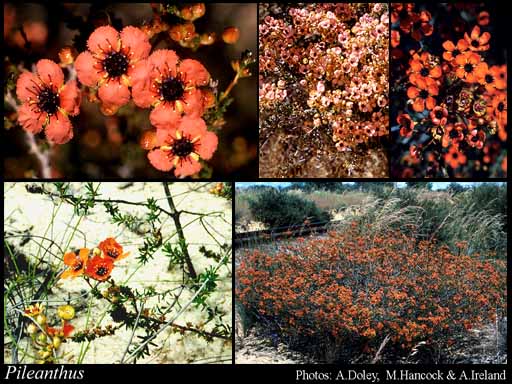- Reference
- Nov.Holl.Pl. p11, t. 149. (1806)
- Name Status
- Current

Scientific Description
Common name. Coppercups. Family Myrtaceae.
Habit and leaf form. Shrubs; evergreen; bearing essential oils. Plants with neither basal nor terminal concentrations of leaves; to 0.4–1.5 m high. Leptocaul. Helophytic to xerophytic. Leaves minute to small; mostly opposite; ‘herbaceous’, or leathery; petiolate to sessile; gland-dotted; aromatic; edgewise to the stem, or with ‘normal’ orientation; simple; epulvinate. Leaf blades dorsiventral, or isobilateral, or centric; entire; solid; terete, or semi-terete, or solid/angular; linear, or lanceolate, or oblong, or ovate; linear; pinnately veined, or parallel-veined, or one-veined; cross-venulate, or without cross-venules. Mature leaf blades adaxially glabrous; abaxially glabrous. Leaves without stipules; without a persistent basal meristem. Leaf anatomy. Hairs absent. Stem anatomy. Secondary thickening developing from a conventional cambial ring.
Reproductive type, pollination. Fertile flowers hermaphrodite. Unisexual flowers absent. Plants hermaphrodite. Entomophilous, or ornithophilous. Pollination mechanism conspicuously specialized, or unspecialized.
Inflorescence and flower features. Flowers aggregated in ‘inflorescences’; in corymbs. Inflorescences simple. The terminal inflorescence unit cymose. Inflorescences terminal. Flowers pedicellate; (bi) bracteolate; small to medium-sized; regular; cyclic. Free hypanthium present (petals ‘inserted on the calyx’); campanulate, or turbinate. Hypogynous disk present. Perianth with distinct calyx and corolla; 15; 2 -whorled; anisomerous. Calyx present; 10; 1 -whorled; gamosepalous; lobed. Calyx segments entire. Calyx spreading; imbricate, or valvate; exceeded by the corolla; regular. Calyx lobes ovate. Corolla present; 5; 1 -whorled; polypetalous; imbricate; regular; white, or red, or pink. Petals obovate. Corolla members entire. Androecial members definite in number. Androecium 20. Androecial members branched. Androecial sequence determinable, or not determinable. Androecial members free of the perianth; all equal, or markedly unequal (in P. filifolius); coherent; 1 - adelphous (connate into a short tube); 1 -whorled. Stamens 20; all more or less similar in shape, or distinctly dissimilar in shape (in P. filifolius); polystemonous; erect in bud, or inflexed in bud. Filaments not geniculate. Anthers dorsifixed; versatile; dehiscing via longitudinal slits; introrse; cells parallel, either contiguous and adnate to the thickened end of the filament or separately attached to the branches of the forked filament; tetrasporangiate; unappendaged. Gynoecium 2 carpelled. The pistil 1 celled. Gynoecium syncarpous; eu-syncarpous; inferior, or partly inferior. Ovary unilocular; 1 locular. Epigynous disk present, or absent. Gynoecium stylate. Styles 1; simple; apical; hairless. Stigmas 1; small. Placentation basal. Ovules in the single cavity 6–10; ascending (on erect, free, excentric placentas); non-arillate; anatropous.
Fruit and seed features. Fruit non-fleshy; indehiscent; 1 celled; usually 1 seeded. Seeds non-endospermic. Cotyledons 2.
Geography, cytology, number of species. Native of Australia. Endemic to Australia. Australian states and territories: Western Australia. South-West Botanical Province.
Etymology. From the Greek for "hat" and "flower"; the buds are covered with two close-fitting bracteoles.
Keys
A Key to Western Australian Species in the Chamelaucieae Tribe of Myrtaceae
B.L. Rye, M.D. Barrett, T.D. Macfarlane, N.S. Lander, M.E. Trudgen, N.G. Marchant, K.R. Thiele